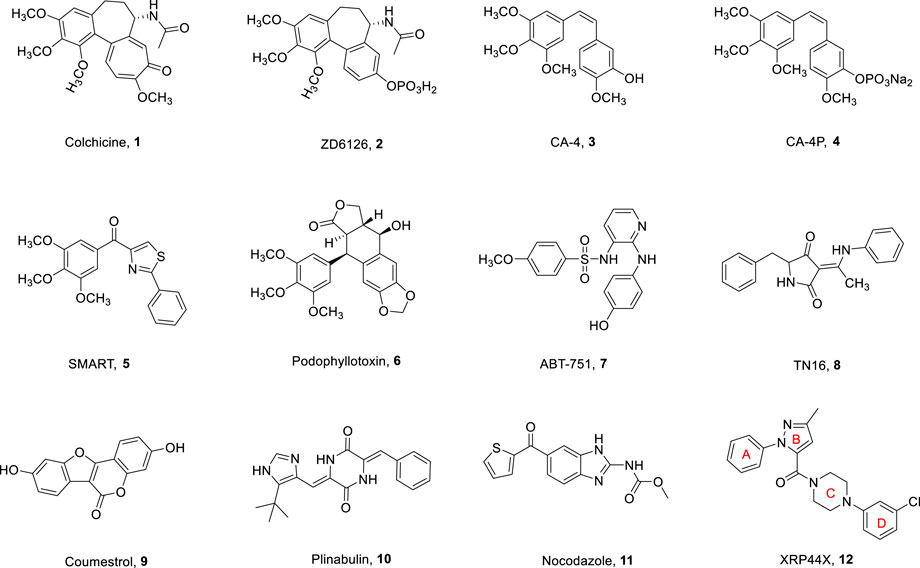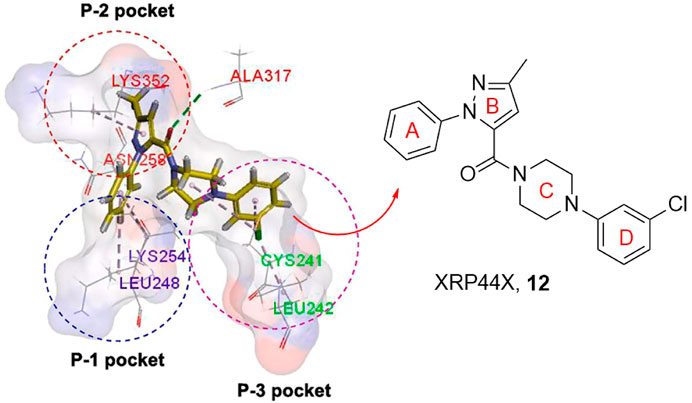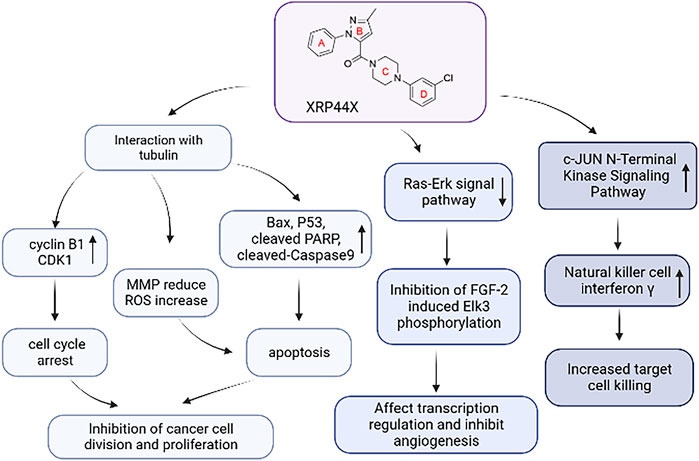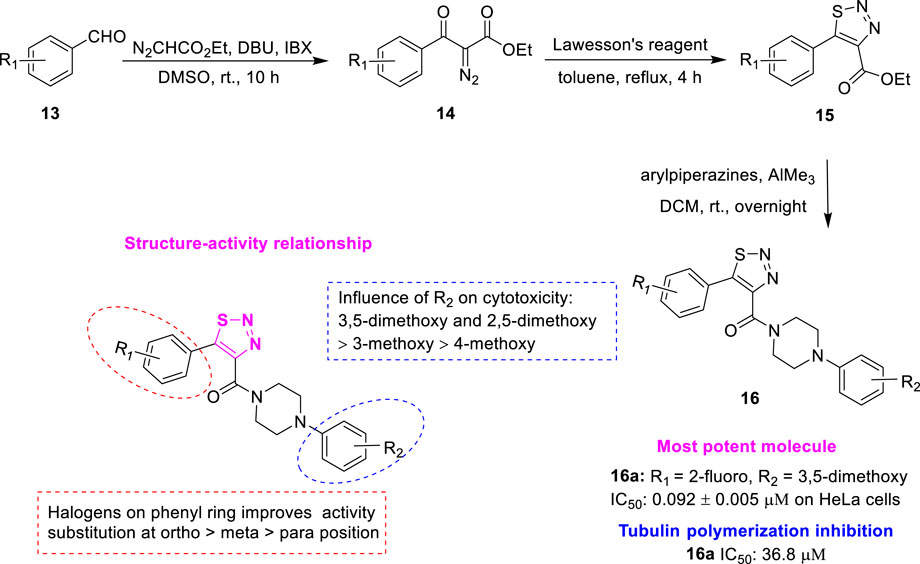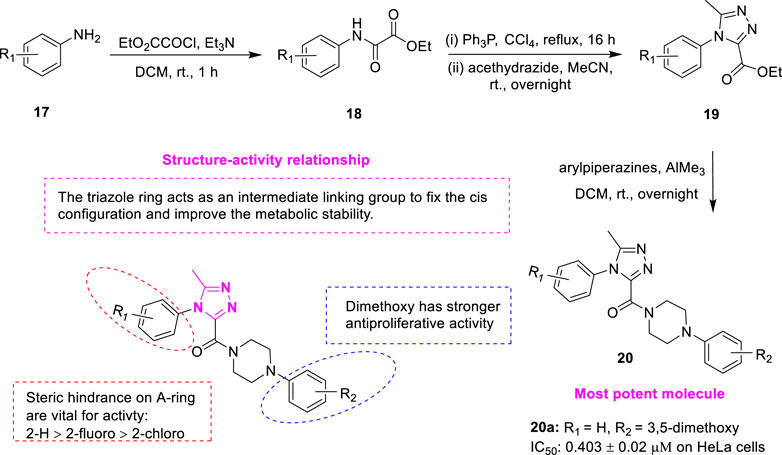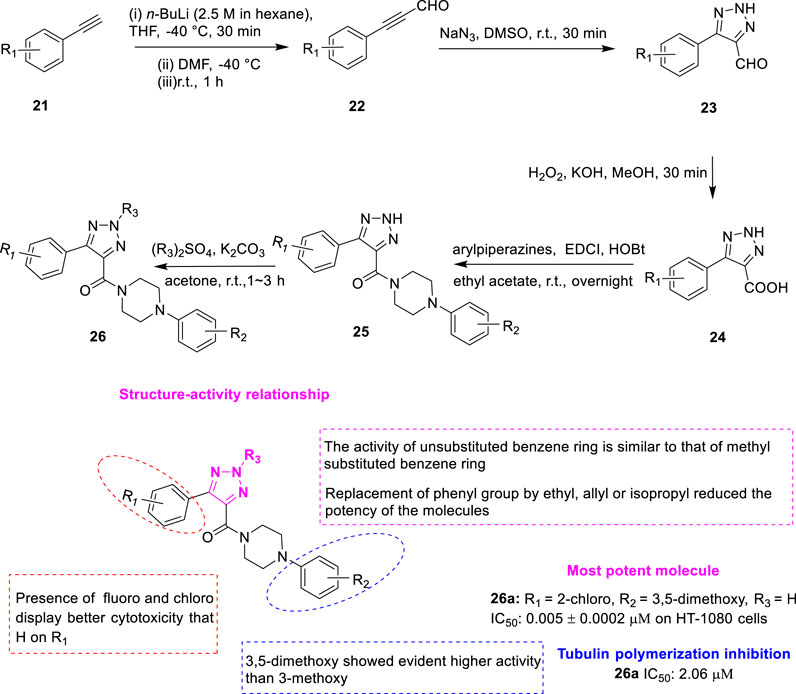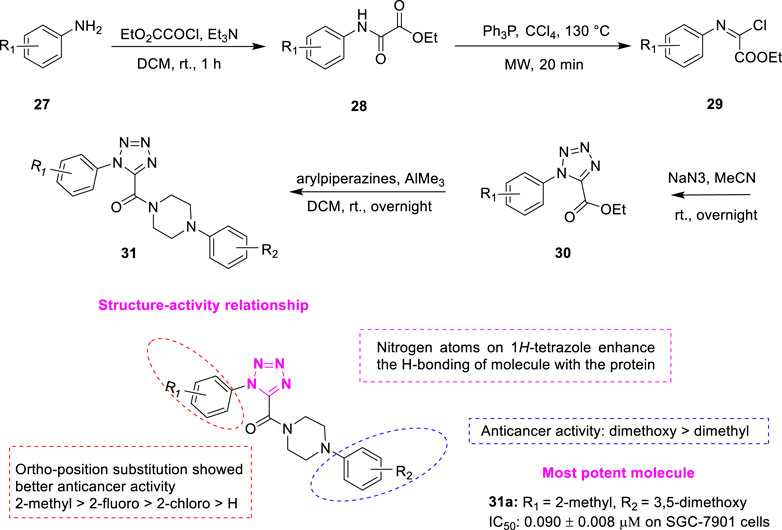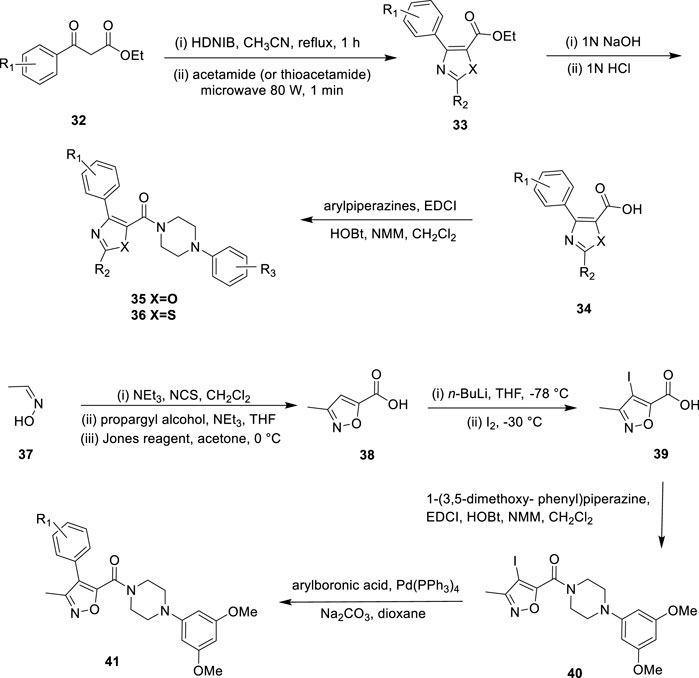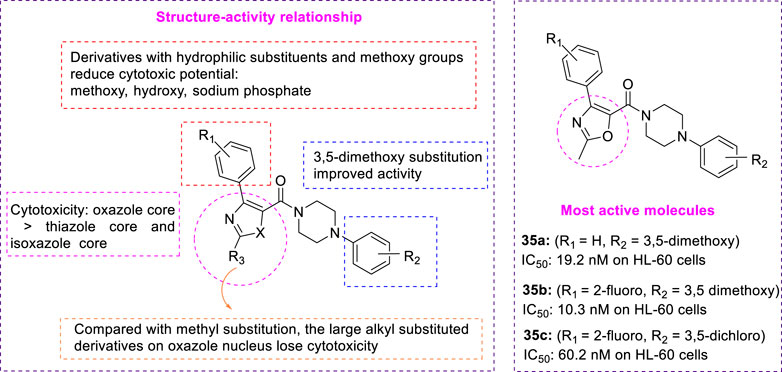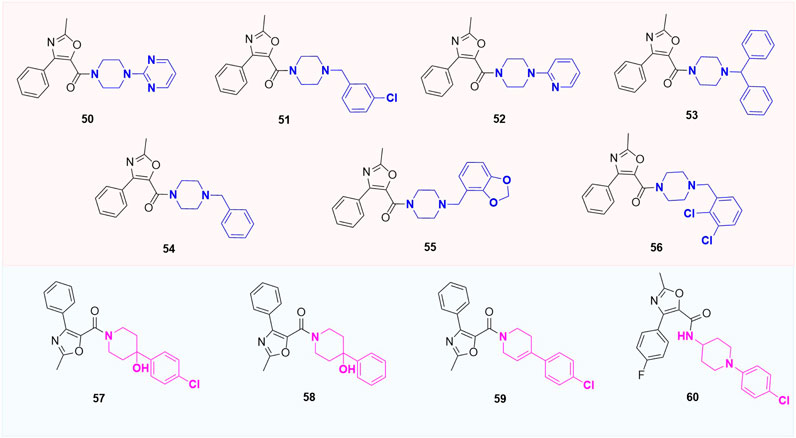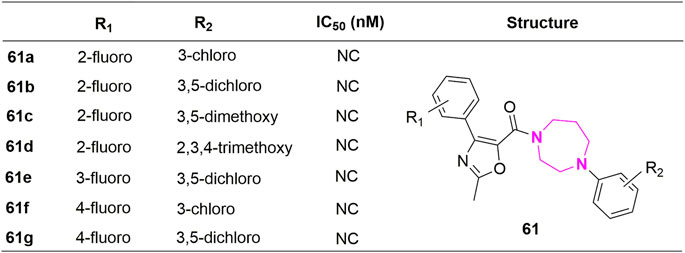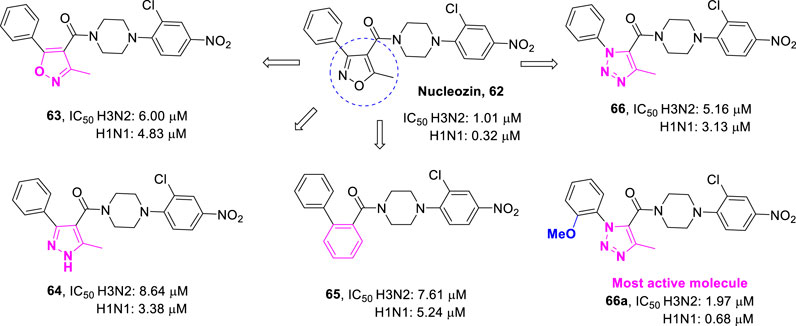- 1Cancer Institute, The Affiliated Hospital of Qingdao University, Qingdao University, Qingdao, China
- 2School of Basic Medicine, Qingdao University, Qingdao, China
- 3School of Life Sciences, Tsinghua University, Beijing, China
Cancer threatens human health and life. Therefore, it is particularly important to develop safe and effective antitumor drugs. Microtubules, the main component of cytoskeleton, play an important role in maintaining cell morphology, mitosis, and signal transduction, which are one of important targets of antitumor drug research and development. Colchicine binding site inhibitors have dual effects of inhibiting proliferation and destroying blood vessels. In recent years, a series of inhibitors targeting this target have been studied and some progress has been made. XRP44X has a novel structure and overcomes some disadvantages of traditional inhibitors. It is also a multifunctional molecule that regulates not only the function of tubulin but also a variety of biological pathways. Therefore, the structure, synthesis, structure-activity relationship, and biological activity of XRP44X analogues reported in recent years were summarized in this paper, to provide a useful reference for the rational design of efficient colchicine binding site inhibitors.
1 Introduction
The International Cancer Research Institute (IARC) released the latest cancer burden data in 2020, which has been used to estimate the latest incidence rate, mortality rate, and cancer development trend of 36 cancer types in 185 countries. Statistics show that 19.29 million people are newly diagnosed with cancer and nearly 10 million people die. Cancer seriously affects human health and threatens human life, and has become one of the major public health problems in the world (Sung et al., 2021; Wang et al., 2021c).
Microtubules are the main components of eukaryotic cytoskeleton, consisting of α-tubulin and β-tubulin, which have dynamic characteristics of depolymerization and polymerization, and play a vital role in cell division, morphological maintenance, and intracellular transport (Wieczorek et al., 2016). Interfering with the dynamic balance of microtubules by inhibiting tubulin polymerization or blocking tubulin decomposition will prevent the normal function of microtubules and eventually lead to cell death (Cao et al., 2018). Given their fundamental role in cell function and growth, microtubules have become an attractive target for the development of antitumor drugs (Chaudhary et al., 2016). Microtubule targeting agents (MTAs) can generally be divided into tubulin depolymerization inhibitors and tubulin polymerization inhibitors, which disrupt microtubule dynamics by binding to tubulin and causing cell death. MTAs are currently known to interact with tubulin through several binding sites: the vinca, laulimalide, maytansine, pironetin, taxane, and colchicine sites (Alpizar-Pedraza et al., 2022; Pal et al., 2022). Clinically applied microtubule targeting agents have been very successful in binding to vinca or taxane sites. These drugs are very effective, but some inhibitors targeting the vinca and taxane sites exhibit multidrug resistance, such as P-glycoprotein-mediated resistance. Colchicine binding site inhibitors (CBSIs) exert their biological activities by inhibiting the important process of tubulin assembly (Eissa et al., 2021). Because of their simple structure, wide therapeutic index, and significant ability to overcome clinically related multidrug resistance, they have attracted much attention in antitumor treatment (Cermak et al., 2020; Hagras et al., 2021). In recent decades, many tubulin inhibitors targeting colchicine binding sites (1–12, Figure 1) have been developed and modified (Gracheva et al., 2020; Xia et al., 2020). Most of these CBSIs with different backbones have strong antiproliferative activity against a variety of human tumor cell lines.
XRP44X is an aryl pyrazole derivative developed by wasylyk et al.. As a new tubulin polymerization inhibitor, XRP44X significantly inhibits the polymerization of tubulin by interacting with the colchicine binding site and shows effective cytotoxic activity on a variety of cancer cell lines at low nanomolar concentrations (Wasylyk et al., 2008). As shown in Figure 1, XRP44X has four rings: A-ring, B-ring, C-ring, D-ring, and a carbonyl bond between B-ring and C-ring. Importantly, XRP44X has a novel structure and overcomes the shortcomings of some traditional CBSIs. Moreover, XRP44X is a multifunctional molecule that not only interacts with tubulin but also has a variety of biological activities. For example, Cheng et al. found that XRP44X analogues can be used as anti-influenza drugs targeting viral nucleoprotein (Cheng et al., 2012). Therefore, the structural skeleton of XRP44X has attracted extensive attention. Many pharmaceutical chemists have developed some compounds with potential antitumor activity by modifying the structure of XRP44X for further research. In recent years, some interesting XRP44X analogues have been reported by modifying the B-ring (five-membered and six-membered heterocyclic hybrids), C-ring (aryl piperazinyl modified), and the substituted phenyl of A- and D-rings. Therefore, we have comprehensively and systematically reviewed the design, synthesis, structure-activity relationship (SAR), and pharmacological activities of XRP44X analogues modified by different heterocycles reported in recent years, to provide research ideas for obtaining CBSIs with better antitumor activity and higher stability.
2 Biological effects of XRP44X
2.1 Interaction with tubulin
XRP44X is an outstanding tubulin polymerization inhibitor. The binding mode of XRP44X or its analogues with tubulin is shown (Figure 2), the binding domain can be divided into P-1, P-2, and P-3 pockets (Wang et al., 2021b). First, the hydrogen bond is formed through the carbonyl group with the amide nitrogen of Alaβ317 and acts as an anchor to place XRP44X in its proper position in the binding pocket. A-ring can match in P-1 pocket Lysβ254 and Leuβ248 binding and enhance the van der Waals interaction between XRP44X and tubulin. Asnβ258 and Lysβ352 in P-2 pocket amino acid residues can form hydrogen bond interaction with the B-ring, and also enhance its van der Waals force. The C-ring and D-ring extend and interact with the hydrophobic P-3 pocket consisting of Leuβ242, Leuβ252, and Cysβ241. The above studies clearly indicate docking patterns between XRP44X and tubulin.
Further studies showed that tubulin polymerization inhibitors can destroy the tubulin skeleton and induce cell cycle arrest by regulating cyclin B1, cyclin-dependent kinase CDK1, etc., (Liang et al., 2021). And they induce apoptosis by regulating the levels of apoptosis-related proteins such as Bax, P53, PARP, and cleaved-Caspase 9. Besides, tubulin polymerization inhibitors reduce mitochondrial membrane potential and increase the level of reactive oxygen species (ROS) in cells (Yan et al., 2022). Excessive ROS can induce oxidative modification of lipids, proteins, or DNA, leading to oxidative stress-induced apoptosis (Circu and Aw, 2010). Tubulin polymerization inhibitors play an antitumor role through the above pathways.
2.2 Interaction with other biological targets
In addition to interacting with tubulin, XRP44X also regulates multiple biological pathways. Transcription factors are powerful drivers of cell transformation and play a significant role in tumorigenesis (Feng et al., 2014). Studies have found that Elk3 of the ETS family is a proto-oncogene transcription factor and a potential therapeutic target for many cancers, including breast cancer and liver cancer. Elk-3 can be phosphorylated and activated by the Ras-Erk signal pathway, and participate in angiogenesis, wound healing, tumor growth, cell adhesion, migration, and invasion (Heo et al., 2015; Kong et al., 2016; Lee et al., 2017). Wasylyk et al. discovered XRP44X, an active inhibitor of Elk3 transcription factor, in small molecule library screening. XRP44X was found to inhibit the phosphorylation of Elk3 induced by fibroblast growth factor 2 (FGF-2) through Ras-Erk signaling. It has also been found to bind to colchicine binding sites of tubulin, depolymerize microtubules, change actin skeleton, stimulate cell membrane foaming, affect transcriptional regulation, block cell cycle processes, and microvascular germination (Wasylyk et al., 2008). Semenchenko et al. conducted a preliminary evaluation of the effect of XRP44X on the tumor in three preclinical mouse models and found that XRP44X inhibits tumor growth and metastasis through mechanisms involving Elk3. These results encourage further research on XRP44X, which could be useful in the development of antitumor drugs.
Natural Killer (NK) cells are cytotoxic lymphocytes that can kill virus-infected cells and cancer cells. Kim and Park found that pyrazole derivative XRP44X stimulated NK cells to enhance cytotoxicity to breast cancer cells. In the presence of XRP44X, natural killer cells showed no obvious apoptosis or impaired cell cycle progression. But XRP44X stimulates interferon γ and activates the c-JUN N-terminal kinase (JNK) signal pathway to enhance the cytotoxicity mediated by NK cells (Kim and Park, 2020). Chen et al. also found that XRP44X and CA-4 induced the depolymerization of tubulin and G2/M phase arrest of the cell cycle through early activation of the JNK pathway (Chen et al., 2012). This study revealed that XRP44X is not only identified as a remarkable CBSI but also acts as an immune stimulator to enhance the cytotoxicity of NK cells to kill cancer cells. This provides a new strategy for the combination of chemotherapy and immunotherapy in the treatment of cancer.
As shown in Figure 3, the above studies confirm that XRP44X can exert biological effects through multiple pathways. Although XRP44X has proven to be a promising lead compound for tubulin polymerization inhibitors, we still need to pay attention to the multi-target compounds to develop drugs that can be used clinically.
3 B-ring modified XRP44X analogues
3.1 Five-membered heterocyclic hybrids
3.1.1 Thiadiazole
Wang et al. designed a series of 5-aryl-4-(4-aryl piperazine-1-carbonyl)-1,2,3-thiadiazole 16 (Figure 4) as new tubulin polymerization inhibitors by replacing the pyrazole portion of XRP44X with the 1,2,3-thiadiazole fragment containing the hydrogen-bond acceptors (Wang et al., 2021b). Initially, the substituted aromatic aldehydes 13 were reacted with ethyl diazoacetate to give the corresponding ethyl 2-diazo-3-oxo-3-arylpropanoates 14. Subsequently, the reaction was commenced using 14 and Lawesson’s reagent to yield the key intermediate ethyl 5-aryl-1,2,3-thiadiazole-4-carboxylates 15. Finally, treatment with the corresponding arylpiperazine in the presence of trimethylaluminum afforded the target compounds 16. The in vitro antiproliferative activity against human cancer cell lines (SGC-7901, A549, HeLa) of the synthesized compounds was further evaluated. Among the target compounds, compound 16a (R1 = 2-fluoro, R2 = 3,5-dimethoxy) showed the best antiproliferative activity against HeLa cells (IC50 = 0.092 ± 0.005 μM), similar to the positive control colchicine (IC50 = 0.086 ± 0.008 μM on HeLa cells). Compound 16a can effectively inhibit tubulin polymerization (IC50 = 36.8 μM). SAR showed significant changes in the activity of all halogenated compounds compared to the non-halogenated compounds, suggesting that electronegativity is crucial for the A-ring. Moreover, halogens on the A-ring exhibited an order of potency being ortho- > meta- > para-substituted generally. It is noteworthy that compounds with substituents at the para-substituted of the A-ring almost lost antiproliferative activity. In addition, compounds with OCH3 on the D-ring interposition substitution showed higher activity than those with the para-substitution, with di-meta-substituted compounds showing increased activity. These results suggest that the volume and lipophilicity of the substituents on the D-ring are important factors affecting the activity. Molecular docking results showed that compound 16a may similarly interact with tubulin to XRP44X. In addition, 1S and 3N of 1,2,3-thiadiazole of compound 16a may form additional hydrogen bonding interactions. This new binding mode in the P-2 pocket was first explored in the design of XRP44X analogues.
3.1.2 Triazole
1,2,4-triazoles is a five-membered aromatic heterocycle containing three nitrogen atoms, which has been of wide interest due to their ease of preparation and the presence of numerous potential pharmacological properties such as antituberculosis (Kahveci et al., 2014), antiviral activity (Gujjar et al., 2009), antioxidant (Flefel et al., 2013) and antitumor activity (Romagnoli et al., 2014). Wang et al. designed and synthesized a series of novel XRP44X analogues 20 (Figure 5) containing 1,2,4-triazoles and investigated antitumor activity and mechanism of action (Wang et al., 2020). The ethyl 2-oxo-2-(arylamino) acetates 18 were synthesized by the commercially available aromatic amines 17 as the starting materials and ethyl oxalate. Compound 18 was reacted with triphenylphosphine to afford the corresponding (E)-ethyl-2-chloro-2-(arylimino) acetates, which further added acethydrazide to yield the key intermediate 5-methyl-4-aryl-4H-1,2,4-triazole-3-carboxylates 19. In the presence of trimethylaluminium, 19 were allowed to react with the corresponding aryl piperazines, affording the final compounds 20. The biological assessment suggested that compound 20a exhibited the strongest antiproliferative activity (IC50 = 0.403 ± 0.02 μM) on Hela human cancer cells. The IC50 of positive control CA-4 on HeLa cells was 0.063 ± 0.015 μM. The stronger activity was attributed to the introduction of the triazole ring as an intermediate linker group, thus fixing the cis-configuration with anti-proliferative activity and improving metabolic stability. The steric hindrance played a key role in the A-ring. For example, compared with 2-chloro, the activities of 2-H and 2-fluoro were greatly improved. The activity of the binary substituted methoxy compounds on the D ring is stronger. Compound 20a effectively inhibited tubulin polymerization, interfered with the normal morphology of intracellular microtubules, significantly inhibited the migration of Hela cells, and caused cell cycle arrest in the G2/M phase in a dose- and time-dependent manner. To investigate the potential binding modes of the target compounds, molecular docking studies were performed using Discovery Studio 3.0 software. It was found that the binding orientations of XRP44X and compound 20a superimposed well with each other. There are hydrogen bonds between Alaβ317 and the carbonyl group of XRP44X and compound 20a, respectively. In addition, the 1N of the 1,2,4-triazole of compound 20a established a critical hydrogen bond with the amino acid residue Lysβ352. The docking results indicated that compound 20a may show its biological activity through the combination with the colchicine site.
Wu et al. discovered two series of aryl triazole analogues as a result of structural modifications of the lead compound XRP44X. Namely, the first class of compounds 25 (Figure 6) with 1,2,3-triazole nitrogen atom unsubstituted and the second class of compounds 26 with 1,2,3-triazole N-2 position hydroalkylated (Wu et al., 2017). Arylacetylene analogues 21 reacted with N,N-dimethylformamide to give arylpropionaldehyde analogues 22. Then azide-alkyne 1,3-dipolar cycloadditions were added to give 5-aryl-2H-1,2,3-triazole-4-carbaldehyde 23, which was then oxidized with hydrogen peroxide to 5-aryl-2H-1,2,3-triazole-4-carboxylic acid 24. Finally, the corresponding arylpiperazine analogues were added to give the desired compound 25 by amidation reaction. The second type of compound 26 could be obtained by the selective hydrocarbylation of the first type of compound 25 at the N-2 position of 1,2,3-triazole. The antiproliferative activity of the synthesized compounds against cancer cells was investigated using an MTT assay. The results showed that most of the compounds exhibited strong antiproliferative activity at submicromolar or nanomolar concentrations, which justified the introduction of the 1,2,3-triazole fragment. Among the designed compounds, 26a (R1 = 2-chloro, R2 = 2-dimethoxy, R3 = H) showed an IC50 value of 5–52 nM towards all 3 cell lines (A549, HT-1080, and SGC-7901), which was comparable to CA-4 (7–48 nM). Compound 26a (IC50 = 2.06 μM) highly inhibited tubulin aggregation in vitro, stronger than the positive control CA-4. Colchicine competitive binding assays further demonstrated that compound 26a is a colchicine binding site inhibitor. SAR showed no significant change in antiproliferative activity for all methylated products compared to the corresponding non-hydrocarbonylated compounds, such as compound 26a. However, the activity was significantly reduced as the bulky alkyl group was introduced. These phenomena suggest that hydrocarbonylation at the N-2 position is not required. Secondly, the effect of the substituents of the benzene ring attached to the piperazine ring was examined, and the results indicated that the spatial effect of the substituents was more important than the electronegativity effect. In addition, the di-meta-substituted compounds have better antiproliferative activity. Finally, the effect of substituents on the aryl ring directly linked to the 1,2,3-triazole core was investigated. Most substitutions failed to improve activity, but electronegativity and position were found to be extremely important for activity. Molecular docking models showed that both 25 and 26 overlapped well with XRP44X. The carbonyl group provides a hydrogen bond Alaβ317 to these three ligands. Although 25 lacks a methyl group, the 2H on its 1,2,3-triazine ring can provide a hydrogen bond to Thrβ353.
3.1.3 Tetrazole
In the last decade, compounds containing 1H-tetrazole scaffolds have attracted great interest due to unique chemical structures and broad-spectrum biological properties including antitumor activity. For example, 1-(3,4,5-trimethoxyphenyl)-5 (4-ethoxyphenyl)-1H-tetrazole was designed as a tubulin inhibitor that showed low IC50 values at the nanomolar level (Romagnoli et al., 2012). Wang et al. designed a series of novel XRP44X analogues 31 (Figure 7) by introducing the hydrogen-bonded receptor 1H-tetrazole as the B-ring of XRP44X (Wang et al., 2021a). Condensation of the substituted aromatic amines 27 and ethyl oxalate gave corresponding intermediates 28, which reacted with triphenylphosphine to afford (E)-ethyl-2-chloro-2-(arylimino) acetates 29. Compound 29 reacted with sodium azide to get the key intermediates ethyl 1-aryl-1H-tetrazole-5 carboxylates 30. Further reaction of 30 with different arylpiperazines in the presence of trimethylaluminium produced the target compound 31. These compounds were found to show good growth inhibitory activity against a series of human cancer cells (SGC-7901, A549, and HeLa). Among them, compound 31a was the most potent compound among all target compounds against the three cancer cell lines (IC50 = 0.090 ± 0.008 μM on SGC-7901 cells). The IC50 of positive control CA-4 was 0.034–0.070 μM. A closer look revealed that the introduction of substituents in the neighboring positions of the R1 significantly enhanced the antiproliferative effect. The overall preference order of the ortho-position is as follows: 2-methyl > 2-fluoro > 2-chloro > H. In addition, the compounds of R2 showed significant antitumor activity in the case of 3,5-dimethoxy phenyl dense. Molecular docking studies revealed that there is a hydrogen bond between Alaβ317 and the carbonyl group of 31a, which has a similar conformation to XRP44X in the binding pocket, and two other hydrogen bonds were observed between Asnβ258, Lysβ352, and 1H-tetrazole. In addition, the study of drug-like properties showed that compound 31a has a lower lipid-water partition coefficient, and may have better water solubility than XRP44X. 31a has six hydrogen bond receptors, far more than XRP44X, which helps to reduce the interaction between the compound and the site.
3.1.4 Oxazole, thiazole, and isoxazole
To develop a new class of antitumor drugs with dual effects: it can not only destroy the tumor vascular system but also prevent mitosis. Choi et al. reported the design, synthesis, and biological evaluation of aryl oxazole, thiazole, and isoxazole analogues as dual-acting antitumor agents, and proposed a new core complete SAR study to determine the basic structural properties required for dual action (Choi et al., 2013). Ethyl 3-oxy-3-phenylpropanoate reacted with [hydroxy (2,4-dinitrobenzene sulfonyl oxy) iodol] benzene and acetamide to form heterocyclic core 33 (Figure 8). Then, 33 was hydrolyzed to obtain fragment 34, and various aryl piperazines were added for a polypeptide coupling reaction to obtain the desired aryl oxazole 35 and thiazole analogues 36. After treatment of (E)-acetaldehyde oxime with triethylamine and N-chlorosuccinimide, propargyl alcohol was added to obtain isoxazole cores. The primary alcohol group was then converted to carboxylic acid to give the isoxazole fragment 38. Iodination of intermediate 38 with n-BuLi and iodine to form compound 39, which reacted with 1-(3,5-dimethoxy phenyl) piperazine to afford intermediate 40. The reaction was performed by aryl boronic acids to yield a series of methyl-substituted isoxazole analogues 41. In vitro, HL-60 (leukemic cells) and HUVEC (human umbilical vein endothelial cells) were used to test the antiproliferation activity and tumor vessel destruction activity of all synthetic compounds. Several compounds with aryl piperazinyl oxazole nuclei showed good cytotoxicity. 35a (R1 = H, R2 = 3,5-dimethoxy, IC50 = 19.2 nM on HL-60 cells) and 35b (R1 = 2-fluoro, R2 = 3,5-dimethoxy, IC50 = 10.3 nM on HL-60 cells) (Figure 9) showed outstanding antitumor activity in comparison with CYT997 (IC50 = 112.3 nM) as reference. SAR showed that the potency of all analogues containing thiazole or isoxazole nuclei was significantly reduced, and it was determined that the antitumor activity of compounds containing oxazole nuclei was crucial. Choi et al. studied the effect of substituents on the benzene ring directly connected to the oxazole nucleus and found that analogues with hydrophilic substituents (such as hydroxide, and sodium phosphate) and methoxy were less effective than their unsubstituted counterparts. This indicated that van der Waals interaction may play an important role in this specific binding region. Compared with the parent compound without any substituent, only the analogues with 3,5-dimethoxy at the R2 position have slightly improved activity, which indicates that there may be hydrogen bond interaction in this region. Choi et al. replaced the methyl groups on the oxazole nucleus with different alkyl groups and found that as the size of the substituents became larger, these analogues completely lost their cytotoxicity. These suggested that the oxazole-binding region can only accommodate a small substitution basis for good interaction.
Considering the biological activity and metabolic stability in vitro, a simple tumor xenotransplantation model (HCT-116, human colorectal cancer) was used to evaluate the antitumor activity of the two most effective compounds 35b (R1 = 2-fluoro, R2 = 3,5-dimethoxy) and 35c (R1 = 2-fluoro, R2 = 3,5-dichloro) in vivo. 35b has better cytotoxicity and vascular destruction activity than 35c. However, compound 35c showed significant microsome stability (82.3% for humans and 49% for mice), while compound 35b seemed only moderately stable in liver microsomes (15% for humans and 16.6% for mice). These two compounds inhibited tubulin polymerization at low concentrations. Interestingly, although 35c is much less potent in vitro than 35b, it has a greater impact on tumor growth in vivo. Compound 35c effectively reduced tumor growth (42.3% in size) at a dose of 100 mg/kg. This compound will be an excellent clue to the discovery of effective double-acting agents.
3.2 Six-membered heterocyclic hybrids
Betzemeier et al. designed and developed a series of aryl piperazine benzamide analogues used as antitumor drugs (Betzemeier et al., 2006). Among them, we found many XRP44X analogues with six-membered benzene ring as B-ring. A series of (1,1′-biphenyl)-2-yl [4-(3,5-dimethoxyphenyl)piperazin-1-yl] methanone analogues (42–49, Figure 10) were prepared according to the method described in the patent, and cytotoxicity and tubulin polymerization inhibition tests were performed in vitro. The results show that the IC50 values of the reported XRP44X analogues are lower than 10 μM and are confirmed as tubulin polymerization inhibitors. Interestingly, XRP44X analogues inhibit angiogenesis and affect the proliferation of abnormal cells, which can be used in the treatment of retinal vascularization and arthritis.
4 Other substituted analogues
Except for the modification of the B-ring, some XRP44X analogues modified with other rings were also reported. Pae et al. substituted aryl piperazine groups on oxazole with various heterocycles (aryl piperidine and homopiperazines) and developed several series of (2-methyl-4-phenyloxazole-5-yl) ketone analogues (50–60, Figure 11) and (2-methyl-4-phenyloxazol-5-yl) (phenylhomo-piperazin-1-yl) methanone analogues (61a-61g, Figure 12). The cytotoxicity of all target compounds on human leukemia cells (HL-60) was tested. However, all the modified compounds in both series completely lost cytotoxicity, further illustrating the importance of the two nitrogen atoms in piperazine-formed hydrogen bond interactions in this region. Moreover, the spatial arrangement that replaces the aryl seems to be the key to a correct combination.
Not all XRP44X analogues have been synthesized as antitumor agents. Some have been developed to fight influenza viruses. Influenza virus nucleoprotein (NP) is a new target for the development of anti-influenza drugs. Kao and Su reported that nucleozin (62, Figure 13) is the first small molecule influenza virus nucleoprotein inhibitor (Kao et al., 2010; Su et al., 2010). The results showed that nucleozin could effectively block the nuclear accumulation of influenza nucleoprotein and showed strong anti-influenza virus activity. With compound 62 as the lead compound, Cheng et al. preliminarily designed isoxazole-4-formamide (63), 1H-pyrazole-4-formamide (64), 2-benzamide (65), and 1H-1,2,3-triazole-4-formamide (66) as new anti-influenza drugs by using the scaffold jumping strategy (Cheng et al., 2012). The anti-influenza A virus activity was determined by the cytopathic effect protection experiment on Madin-Darby canine kidney (MDCK) cells. By further structural optimization, the anti-influenza activity of these compounds was improved, even comparable to that of compound 62. One of the most effective compounds 66a inhibited the replication of various H1N1 and H3N2 influenza A virus strains, with IC50 values ranging from 0.7 to 2.0 μM. Compound 66a also strongly inhibited the replication of H5N1 (RG14), anti-oseltamivir A/WSN/1933 (H1N1, 274Y), and anti-Amartidine A/WSN/33 (H1N1) virus strains, with IC50 values in sub micromolar range. Further computational and mechanism studies indicated that 66a may directly target influenza virus A nuclear protein to inhibit its nuclear accumulation. This research provides a series of new lead compounds for the development of anti-influenza drugs targeting influenza virus nucleoprotein.
Whether used as antitumor drugs targeting microtubules or as anti-influenza drugs, the potential XRP44X analogues are on the way to the clinic. Therefore, it is very necessary to develop new tubulin inhibitors which can be used in clinical treatment.
5 Conclusion
In recent years, colchicine binding site inhibitors have attracted much attention due to their targeting specificity and strong antitumor activity. XRP44X is a novel CBSI with novel structure, strong activity, and wide biological role, which is regarded by many researchers as the basis for designing and developing new chemical structures. We comprehensively and systematically reviewed the design, synthesis, structure-activity relationship, pharmacological activity, and various biological effects of the new XRP44X analogues. The research found that the most popular design strategy of XRP44X analogues is to replace the B-ring with other five-membered nitrogen heterocycles (thiadiazole, triazole, tetrazole, thiazole, oxazole, and isoxazole). In addition to five-membered heterocyclic modifications, a series of XRP44X analogues replaced by six-membered heterocyclic rings have been reported on the B-ring. The carbonyl bond between the B- and C-rings was considered to be the basis of tubulin activity. Interestingly, the antitumor activity of the piperazine group on the oxazole ring was greatly reduced after it was replaced by aryl piperidine or homopiperazine groups, indicating the importance of the two nitrogen atoms in piperazine-formed hydrogen bond interaction in this region. From the above studies, it can be seen that the electronegativity of substituted aryl groups on the A ring is essential for antitumor activity. The volume and lipophilicity of the substituted aryl group on the D-ring are important factors affecting the activity. The substituted aryl group of 3, 5-dimethoxy-phenyl group on the D-ring shows significant antitumor activity. Molecular docking studies have shown that XRP44X analogues are well bound to tubulin. XRP44X and its analogues have been prepared as anti-influenza drugs targeting viral nucleoprotein in addition to their antitumor activities. Hence, the design and biological activity of XRP44X analogues still need further study, especially in the aspects of normal cell selectivity, study and simulation of ADMET, evaluation of various tumor models in vivo, pharmacokinetics, toxicology, and drug action mechanism. Considering the latest progress described in this review article, it is obvious that the development of XRP44X analogues enriches the library of compounds targeting tubulin, contributes to further structural adjustment, and provides candidate compounds for the development of antitumor drugs.
Author contributions
CW and DX outlined the research strategy and idea. CW and LS summarized, wrote and revised the paper. SY, JC, WL, JZ, JM, and RZ looked at the literature and plotted graphs. All authors have read and agreed to the published version of the manuscript.
Funding
This work was supported by the grants from the Medical and Health Science and Technology Development Plan Project of Shandong (202113051140).
Conflict of interest
The authors declare that the research was conducted in the absence of any commercial or financial relationships that could be construed as a potential conflict of interest.
Publisher’s note
All claims expressed in this article are solely those of the authors and do not necessarily represent those of their affiliated organizations, or those of the publisher, the editors and the reviewers. Any product that may be evaluated in this article, or claim that may be made by its manufacturer, is not guaranteed or endorsed by the publisher.
References
Alpizar-Pedraza, D., Veulens, A. D., Araujo, E. C., Piloto-Ferrer, J., and Sanchez-Lamar, A. (2022). Microtubules destabilizing agents binding sites in tubulin. J. Mol. Struct. 1259, 132723. doi:10.1016/j.molstruc.2022.132723
Betzemeier, B., Krist, B., McConnell, D., Steurer, S., Impagnatiello, M., Weyer-Czernilofsky, U., et al. (2006). Arylpiperazine-benzoylamide analogues useful as pharmaceutical agents. Patent EP 1645556A1.
Cao, Y. N., Zheng, L. L., Wang, D., Liang, X. X., Gao, F., and Zhou, X. L. (2018). Recent advances in microtubule-stabilizing agents. Eur. J. Med. Chem. 143, 806–828. doi:10.1016/j.ejmech.2017.11.062
Cermak, V., Dostal, V., Jelinek, M., Libusova, L., Kovar, J., Rosel, D., et al. (2020). Microtubule-targeting agents and their impact on cancer treatment. Eur. J. Cell Biol. 99 (4), 151075. doi:10.1016/j.ejcb.2020.151075
Chaudhary, V., Venghateri, J. B., Dhaked, H. P. S., Bhoyar, A. S., Guchhait, S. K., and Panda, D. (2016). Novel combretastatin-2-aminoimidazole analogues as potent tubulin assembly inhibitors: Exploration of unique pharmacophoric impact of bridging skeleton and aryl moiety. J. Med. Chem. 59 (7), 3439–3451. doi:10.1021/acs.jmedchem.6b00101
Chen, J., Sun, W. L., Wasylyk, B., Wang, Y. P., and Zheng, H. (2012). c-Jun N-terminal kinase mediates microtubule-depolymerizing agent-induced microtubule depolymerization and G2/M arrest in MCF-7 breast cancer cells. Anti-Cancer Drugs 23 (1), 98–107. doi:10.1097/CAD.0b013e32834bc978
Cheng, H., Wan, J., Lin, M. I., Liu, Y., Lu, X., Liu, J., et al. (2012). Design, synthesis, and in vitro biological evaluation of 1H-1,2,3-Triazole-4-carboxamide derivatives as new anti-influenza A agents targeting virus nucleoprotein. J. Med. Chem. 55 (5), 2144–2153. doi:10.1021/jm2013503
Choi, M. J., No, E. S., Thorat, D. A., Jang, J. W., Yang, H., Lee, J., et al. (2013). Synthesis and biological evaluation of aryloxazole derivatives as antimitotic and vascular-disrupting agents for cancer therapy. J. Med. Chem. 56 (22), 9008–9018. doi:10.1021/jm400840p
Circu, M. L., and Aw, T. Y. (2010). Reactive oxygen species, cellular redox systems, and apoptosis. Free Radic. Biol. Med. 48 (6), 749–762. doi:10.1016/j.freeradbiomed.2009.12.022
Eissa, I. H., Dahab, M. A., Ibrahim, M. K., Alsaif, N. A., Alanazi, A. Z., Eissa, S. I., et al. (2021). Design and discovery of new antiproliferative 1,2,4-triazin-3(2H)-ones as tubulin polymerization inhibitors targeting colchicine binding site. Bioorg. Chem. 112, 104965. doi:10.1016/j.bioorg.2021.104965
Feng, F. Y., Brenner, J. C., Hussain, M., and Chinnaiyan, A. M. (2014). Molecular pathways: Targeting ETS gene fusions in cancer. Clin. Cancer Res. 20 (17), 4442–4448. doi:10.1158/1078-0432.Ccr-13-0275
Flefel, E. M., Tantawy, W. A., El-Sayed, W. A., Sayed, H. H., and Fathy, N. M. (2013). Synthesis and anticancer activity of new substituted pyrazoles and their derived 1,2,4-triazoles and sugar derivatives. J. Heterocycl. Chem. 50 (2), 344–350. doi:10.1002/jhet.1122
Gracheva, I. A., Shchegravina, E. S., Schmalz, H. G., Beletskaya, I. P., and Fedorov, A. Y. (2020). Colchicine alkaloids and synthetic analogues: Current progress and perspectives. J. Med. Chem. 63 (19), 10618–10651. doi:10.1021/acs.jmedchem.0c00222
Gujjar, R., Marwaha, A., El Mazouni, F., White, J., White, K. L., Creason, S., et al. (2009). Identification of a metabolically stable triazolopyrimidine-based dihydroorotate dehydrogenase inhibitor with antimalarial activity in mice. J. Med. Chem. 52 (7), 1864–1872. doi:10.1021/jm801343r
Hagras, M., El Deeb, M. A., Elzahabi, H. S. A., Elkaeed, E. B., Mehany, A. B. M., and Eissa, I. H. (2021). Discovery of new quinolines as potent colchicine binding site inhibitors: Design, synthesis, docking studies, and anti-proliferative evaluation. J. Enzyme Inhibition Med. Chem. 36 (1), 640–658. doi:10.1080/14756366.2021.1883598
Heo, S. H., Lee, J. Y., Yang, K. M., and Park, K. S. (2015). ELK3 expression correlates with cell migration, invasion, and membrane type 1-matrix metalloproteinase expression in MDA-MB-231 breast cancer cells. Gene Expr. 16 (4), 197–203. doi:10.3727/105221615x14399878166276
Kahveci, B., Menteşe, E., Akkaya, E., Yılmaz, F., Doğan, I. S., and Ozel, A. (2014). Synthesis of some novel 1,2,4-triazol-3-one analogues bearing the salicyl moiety and their anticonvulsant activities. Arch. Pharm. Weinh. 347 (6), 449–455. doi:10.1002/ardp.201300427
Kao, R. Y., Yang, D., Lau, L. S., Tsui, W. H., Hu, L., Dai, J., et al. (2010). Identification of influenza A nucleoprotein as an antiviral target. Nat. Biotechnol. 28 (6), 600–605. doi:10.1038/nbt.1638
Kim, K. S., and Park, K. S. (2020). XRP44X enhances the cytotoxic activity of natural killer cells by activating the c-JUN N-terminal kinase signaling pathway. Dev. Reprod. 24 (1), 53–62. doi:10.12717/dr.2020.24.1.53
Kong, S. Y., Kim, K. S., Kim, J., Kim, M. K., Lee, K. H., Lee, J. Y., et al. (2016). The ELK3-GATA3 axis orchestrates invasion and metastasis of breast cancer cells in vitro and in vivo. Oncotarget 7 (40), 65137–65146. doi:10.18632/oncotarget.11427
Lee, J. H., Hur, W., Hong, S. W., Kim, J. H., Kim, S. M., Lee, E. B., et al. (2017). ELK3 promotes the migration and invasion of liver cancer stem cells by targeting HIF-1α. Oncol. Rep. 37 (2), 813–822. doi:10.3892/or.2016.5293
Liang, Y., Zhang, M., Zhou, P., Liu, M., Li, J., and Wang, Y. (2021). Design, synthesis and antitumor evaluation of novel chiral diaryl substituted azetidin-2-one derivatives as tubulin polymerization inhibitors. Bioorg Chem. 115, 105239. doi:10.1016/j.bioorg.2021.105239
Pal, D., Song, I. H., Warkad, S. D., Song, K. S., Yeom, G. S., Saha, S., et al. (2022). Indazole-based microtubule-targeting agents as potential candidates for anticancer drugs discovery. Bioorg. Chem. 122, 105735. doi:10.1016/j.bioorg.2022.105735
Romagnoli, R., Baraldi, P. G., Salvador, M. K., Prencipe, F., Bertolasi, V., Cancellieri, M., et al. (2014). Synthesis, antimitotic and antivascular activity of 1-(3 ',4 ',5 '-Trimethoxybenzoyl)-3-arylamino-5-amino-1,2,4-triazoles. J. Med. Chem. 57 (15), 6795–6808. doi:10.1021/jm5008193
Romagnoli, R., Baraldi, P. G., Salvador, M. K., Preti, D., Tabrizi, M. A., Brancale, A., et al. (2012). Synthesis and evaluation of 1,5-disubstituted tetrazoles as rigid analogues of combretastatin A-4 with potent antiproliferative and antitumor activity. J. Med. Chem. 55 (1), 475–488. doi:10.1021/jm2013979
Su, C. Y., Cheng, T. J., Lin, M. I., Wang, S. Y., Huang, W. I., Lin-Chu, S. Y., et al. (2010). High-throughput identification of compounds targeting influenza RNA-dependent RNA polymerase activity. Proc. Natl. Acad. Sci. U. S. A. 107 (45), 19151–19156. doi:10.1073/pnas.1013592107
Sung, H., Ferlay, J., Siegel, R. L., Laversanne, M., Soerjomataram, I., Jemal, A., et al. (2021). Global cancer statistics 2020: GLOBOCAN estimates of incidence and mortality worldwide for 36 cancers in 185 countries. Ca-a Cancer J. Clin. 71 (3), 209–249. doi:10.3322/caac.21660
Wang, C., Li, Y. L., Liu, T., Wang, Z. Y., Zhang, Y. J., Bao, K., et al. (2020). Design, synthesis and evaluation of antiproliferative and antitubulin activities of 5-methyl-4-aryl-3-(4-arylpiperazine-1-carbonyl)-4H-1,2,4-triazoles. Bioorg. Chem. 104, 103909. doi:10.1016/j.bioorg.2020.103909
Wang, C., Li, Y. L., Liu, Z., Wang, Z. Y., Liu, Z. H., Man, S., et al. (2021a). Design, synthesis and biological evaluation of 1-Aryl-5-(4-arylpiperazine-1-carbonyl)-1H-tetrazols as novel microtubule destabilizers. J. Enzyme Inhibition Med. Chem. 36 (1), 549–560. doi:10.1080/14756366.2020.1759582
Wang, C., Wang, Z. Y., Gao, M. H., Li, Y. L., Zhang, Y. J., Bao, K., et al. (2021b). Design, synthesis and anticancer activity of 5-aryl-4-(4-arylpiperazine-1-carbonyl)-1,2,3-thiadiazoles as microtubule-destabilizing agents. Bioorg. Chem. 106, 104199. doi:10.1016/j.bioorg.2020.104199
Wang, C., Zhang, Y. J., Wu, Y. D., and Xing, D. M. (2021c). Developments of CRBN-based PROTACs as potential therapeutic agents. Eur. J. Med. Chem. 225, 113749. doi:10.1016/j.ejmech.2021.113749
Wasylyk, C., Zheng, H., Castell, C., Debussche, L., Multon, M. C., and Wasylyk, B. (2008). Inhibition of the ras-net (Elk-3) pathway by a novel pyrazole that affects microtubules. Cancer Res. 68 (5), 1275–1283. doi:10.1158/0008-5472.Can-07-2674
Wieczorek, M., Tcherkezian, J., Bernier, C., Prota, A. E., Chaaban, S., Rolland, Y., et al. (2016). The synthetic diazonamide DZ-2384 has distinct effects on microtubule curvature and dynamics without neurotoxicity. Sci. Transl. Med. 8 (365), 365ra159. doi:10.1126/scitranslmed.aag1093
Wu, Y., Feng, D. J., Gao, M. Q., Wang, Z. W., Yan, P., Gu, Z. Z., et al. (2017). Design and synthesis of 5-aryl-4-(4-arylpiperazine-1-carbonyl)-2H-1,2,3-triazole derivatives as colchicine binding site inhibitors. Sci. Rep. 7, 17120. doi:10.1038/s41598-017-17449-0
Xia, L. Y., Zhang, Y. L., Yang, R., Wang, Z. C., Lu, Y. D., Wang, B. Z., et al. (2020). Tubulin inhibitors binding to colchicine-site: A review from 2015 to 2019. Curr. Med. Chem. 27 (40), 6787–6814. doi:10.2174/0929867326666191003154051
Yan, X. Y., Leng, J. F., Chen, T. T., Zhao, Y. J., Kong, L. Y., and Yin, Y. (2022). Design, synthesis, and biological evaluation of novel diphenylamine derivatives as tubulin polymerization inhibitors targeting the colchicine binding site. Eur. J. Med. Chem. 237, 114372. doi:10.1016/j.ejmech.2022.114372
Keywords: colchicine binding site inhibitors, XRP44X, structural modification, SAR, antitumor activity
Citation: Wang C, Shi L, Yang S, Chang J, Liu W, Zeng J, Meng J, Zhang R and Xing D (2023) Research progress on antitumor activity of XRP44X and analogues as microtubule targeting agents. Front. Chem. 11:1096666. doi: 10.3389/fchem.2023.1096666
Received: 12 November 2022; Accepted: 20 February 2023;
Published: 01 March 2023.
Edited by:
M. D. Musawwer Khan, Aligarh Muslim University, IndiaReviewed by:
Ahmed H. E. Hassan, Mansoura University, EgyptSahil Sharma, Memorial Sloan Kettering Cancer Center, United States
Copyright © 2023 Wang, Shi, Yang, Chang, Liu, Zeng, Meng, Zhang and Xing. This is an open-access article distributed under the terms of the Creative Commons Attribution License (CC BY). The use, distribution or reproduction in other forums is permitted, provided the original author(s) and the copyright owner(s) are credited and that the original publication in this journal is cited, in accordance with accepted academic practice. No use, distribution or reproduction is permitted which does not comply with these terms.
*Correspondence: Chao Wang, d2FuZ2NoYW8yMDA4NjkyNUAxMjYuY29t; Dongming Xing, eGRtX3RzaW5naHVhQDE2My5jb20=
†These authors have contributed equally to this work
 Chao Wang
Chao Wang Lingyu Shi
Lingyu Shi Shanbo Yang
Shanbo Yang Jing Chang
Jing Chang Wenjing Liu
Wenjing Liu Jun Zeng
Jun Zeng Jingsen Meng
Jingsen Meng Renshuai Zhang
Renshuai Zhang Dongming Xing
Dongming Xing